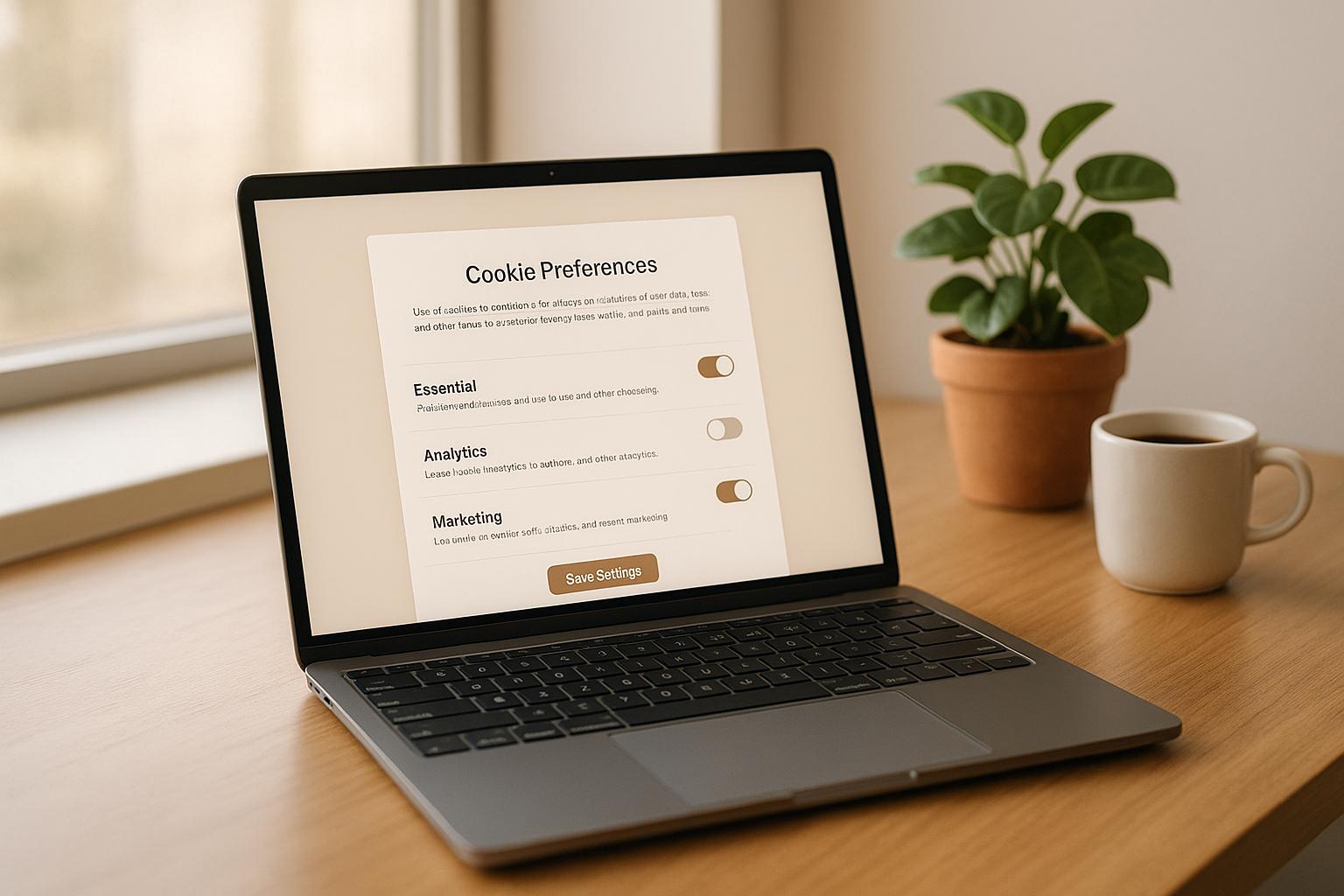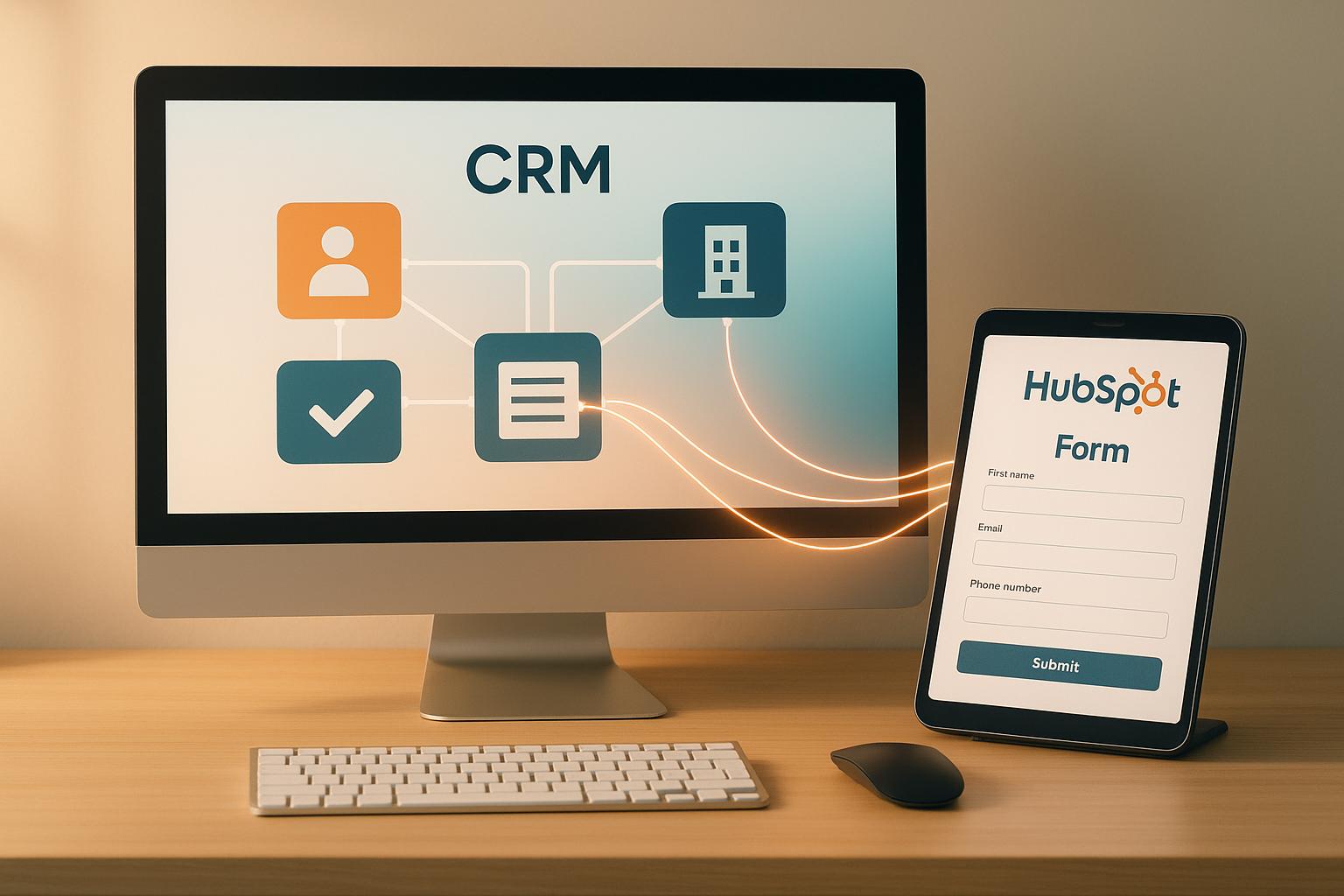How Cookie Categories Impact Compliance

Want to comply with GDPR and CCPA? Start by categorizing your cookies. Here's why it matters and how to do it:
-
Cookie Types:
- Necessary: No consent needed (e.g., login sessions).
- Performance: Tracks analytics; requires consent.
- Functionality: Stores user preferences; requires consent.
- Advertising: Ad targeting; needs explicit consent.
-
Compliance Essentials:
- GDPR: Requires opt-in consent for non-essential cookies.
- CCPA: Focuses on transparency and opt-out options.
-
Steps to Stay Compliant:
- Audit and categorize cookies.
- Use consent tools for opt-in/opt-out preferences.
- Keep detailed records of cookie data and user consent.
Proper classification reduces legal risks, builds trust, and ensures user-friendly consent management.
CookieYes Demo: Cookie Compliance with GDPR and CCPA

Cookie Categories and Their Uses
Organizing cookies into clear categories is essential for meeting privacy laws and ensuring proper user consent. The table below highlights the main cookie types and their consent requirements.
Types of Cookies
| Cookie Category | Primary Purpose | Examples | Consent Requirements |
|---|---|---|---|
| Necessary | Basic website operations | Login sessions, shopping carts | No consent needed |
| Performance | Analytics and site performance | Page load times, error tracking | Requires consent |
| Functionality | User settings and features | Language preferences, theme choices | Requires consent |
| Advertising | Marketing and ad targeting | Ad personalization, tracking | Explicit consent required |
Necessary cookies are crucial for core website functions, like keeping users logged in or retaining items in a shopping cart during checkout.
Performance cookies help track how users interact with a site. They gather data like page load speeds, popular pages, and error reports, which helps improve the site’s overall performance.
Functionality cookies store user preferences, such as language selection or dashboard settings, making the site more user-friendly.
Advertising cookies monitor user activity across websites to deliver tailored ads. Since these cookies often involve sensitive data, they require explicit consent.
Properly categorizing cookies not only explains their roles but also ensures compliance with legal standards.
Categorization for Legal Compliance
To comply with privacy regulations, organizations need to classify their cookies correctly. This helps to:
- Clearly explain how user data is collected and used
- Allow users to choose which cookie categories they want to accept
- Maintain records to prove compliance with legal requirements
A thorough cookie categorization process includes regular audits. Each cookie should be documented with details such as:
- Its purpose and function
- The type of data it collects
- Its expiration date
- Any third parties accessing the data
- The legal basis for its use
This documentation is vital for privacy audits and shows adherence to regulations like GDPR and CCPA. Regularly revisiting cookie classifications ensures accuracy as websites evolve, laying the groundwork for meeting specific legal obligations.
GDPR and CCPA Cookie Rules
GDPR Cookie Rules
The GDPR requires businesses to get explicit user consent before using non-essential cookies. This consent must meet the following criteria:
- Freely given - Users should have a real choice and shouldn't be forced to accept cookies to access basic services.
- Specific - Consent must be obtained for each cookie category separately.
- Informed - Users need clear details about why cookies are used and how their data will be handled.
- Unambiguous - Consent must involve an active opt-in. Pre-checked boxes are not allowed.
Cookie banners under GDPR provide detailed information about data collection, including how data is processed and whether it's shared with third parties. These banners also let users decide which types of cookies they want to accept or reject.
CCPA Cookie Rules
The CCPA takes a different approach, focusing on transparency and giving users the right to opt out of having their personal information sold. Here's what businesses need to do:
- Collection Notice - Inform users about the personal data collected through cookies.
- Right to Opt-Out - Clearly provide an option for users to opt out of data sales.
- Privacy Policy Disclosures - Include detailed explanations of cookie usage and data-sharing practices in the company's privacy policy.
- "Do Not Sell" Option - Offer a prominent link that allows users to opt out of data sales.
GDPR vs. CCPA Requirements
Comparing the two frameworks highlights their key differences. GDPR enforces an opt-in model with detailed control over cookie categories, while CCPA prioritizes transparency and opt-out options.
To meet both standards, businesses can take these steps:
- Conduct Cookie Scans - Regularly audit and categorize all cookies in use.
- Update Privacy Notices - Ensure cookie practices and data collection details are clear and easy to find.
- Use Consent Management Tools - Implement systems that handle both GDPR opt-in and CCPA opt-out requirements.
- Keep Records - Document cookie purposes, categories, and user consent choices thoroughly.
For companies operating worldwide, aligning with GDPR's stricter rules can simplify compliance across different regions.
sbb-itb-5f36581
Benefits of Cookie Classification
Classifying cookies properly not only supports compliance but also strengthens user trust. Effective cookie management plays a key role in meeting legal requirements and improving the user experience.
Reducing Legal Risk
Organizing and categorizing cookies helps businesses stay on the right side of the law and avoid penalties. By using a structured classification system, organizations can:
- Track and document the purpose of each cookie.
- Respond quickly to audits and regulatory inquiries.
- Remove cookies that don’t meet compliance standards.
- Keep cookie policies up-to-date.
- Adopt privacy measures that align with regulations.
Beyond reducing legal risks, clear classification also simplifies how users interact with consent settings.
Managing User Consent
When cookies are categorized effectively, users gain better control over their data. This approach offers:
- Easy-to-understand options for giving or withdrawing consent.
- Clear explanations of how data is collected and used.
- Efficient systems for tracking and updating consent preferences.
- Faster responses to user requests.
- Simplified management of preferences across different websites.
A well-organized system ensures businesses can adapt to various regulatory requirements by:
- Using the right consent mechanisms for each cookie type.
- Changing data collection practices as needed.
- Monitoring compliance across multiple websites.
- Keeping privacy policies accurate and up-to-date.
These improvements in consent management support broader compliance efforts. Regular reviews and solid documentation further strengthen a company’s approach to cookie management.
Cookie Management Guidelines
To comply with GDPR and CCPA, you need a structured approach to cookie management. This includes conducting regular reviews and maintaining accurate records of cookie categories and user consent.
Regular Cookie Reviews
Frequent reviews help ensure that cookie categories are correctly labeled and that consent mechanisms are working as intended.
Detailed Cookie Documentation
Keep a record of cookie categories, their purposes, and user consent details. Having up-to-date documentation makes it easier to monitor and address any changes in cookie behavior.
Tools for Managing Consent
Reform's form builder simplifies the process by creating clear consent forms and dynamic preference centers. It automates consent logging and integrates with privacy frameworks, making data collection and consent management more efficient.
Conclusion
Accurate cookie classification is key to staying compliant with privacy laws like GDPR and CCPA. Regularly reviewing cookies not only helps reduce legal risks but also strengthens user trust.
To achieve this, organizations need a clear process that includes frequent cookie reviews, thorough documentation, and reliable consent management tools. Reform's form builder simplifies this process by automating consent logging and providing dynamic preference centers, making compliance easier while keeping the focus on user experience.
Staying on top of cookie compliance means keeping up with regulatory changes and maintaining transparency. By streamlining cookie categorization, organizations can meet legal requirements and show their commitment to protecting user privacy.
FAQs
What are the main differences between GDPR and CCPA regarding cookie consent?
The GDPR and CCPA differ in how they approach cookie consent. Under the GDPR, businesses must obtain clear and explicit consent from users before collecting or processing cookies, particularly those that track personal data. Users must also have the ability to opt out or withdraw consent at any time. Additionally, businesses are required to categorize cookies (e.g., essential, analytics, marketing) and provide detailed information about their purpose.
The CCPA, on the other hand, does not mandate prior consent for cookies. Instead, it focuses on giving users the right to opt out of the sale of their personal information, which can include data collected through cookies. Businesses must include a clear "Do Not Sell My Personal Information" link on their website and disclose how cookies are used to collect and share data.
In summary, GDPR emphasizes prior consent and transparency, while CCPA centers on providing opt-out rights and ensuring data-sharing practices are clear to users.
How can businesses audit and categorize cookies to comply with privacy laws like GDPR and CCPA?
To ensure compliance with privacy laws such as GDPR and CCPA, businesses should start by conducting a comprehensive cookie audit. This involves identifying all cookies used on their website, including first-party and third-party cookies, and documenting their purpose, duration, and the data they collect.
Once identified, categorize cookies into groups such as essential cookies (necessary for website functionality), analytics cookies, marketing cookies, and functional cookies. This categorization helps businesses provide clear, transparent information to users and enables proper consent management, ensuring users can opt in or out of non-essential cookies.
Regularly reviewing and updating cookie policies is also critical to maintaining compliance as privacy regulations evolve.
How do proper cookie categorization and tools like Reform's form builder help with privacy law compliance?
Properly categorizing cookies is essential for complying with privacy laws like GDPR and CCPA. By organizing cookies into clear categories - such as strictly necessary, performance, functional, and targeting cookies - businesses can provide users with transparency and control over their data. This not only ensures compliance but also builds trust with website visitors.
Using tools like Reform's form builder can simplify the process of managing cookie consent. Reform allows businesses to create branded, user-friendly forms that streamline consent collection while ensuring accessibility and compliance. Its features, such as conditional routing and real-time analytics, help optimize user interactions and maintain a seamless experience while adhering to legal requirements.
Related posts
Get new content delivered straight to your inbox

The Response
Updates on the Reform platform, insights on optimizing conversion rates, and tips to craft forms that convert.
Drive real results with form optimizations
Tested across hundreds of experiments, our strategies deliver a 215% lift in qualified leads for B2B and SaaS companies.





